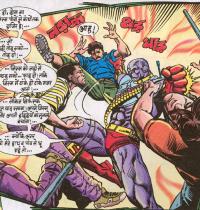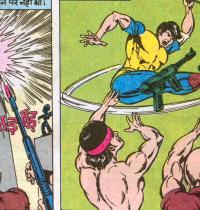Bharath Murthy
Grant Period: Nine Months
Bharath Murthy first studied painting at M. S. University, Baroda, and then filmmaking at the Satyajit Ray Film and TV Institute, Kolkata. This grant will enable Bharath to bring his twin interests in painting and film to bear on the universe of modern comic books. He will research comic book culture in India towards developing a script/storyboard for a film or a comic book. Bharath recalls that his first drawings were copies of Tintin, Asterix and other superheroes. Later at art school he was introduced to Picasso and Gauguin, Pop Art and Andy Warhol and found himself revisiting his childhood obsession with comic books. As a film student, his passion for visual narrative became further apparent. This is when the comic book style of using images and words for sequential storytelling began to influence all his work: his drawings became more filmic and his films became more ‘cartoonish’.
Over the years, comic books have undergone an independent evolution, parallel to that of modern art and films, to become the ‘graphic novels’ of today. “Historically, the cult appeal of comic books has been much criticized, especially in English-speaking countries, which harbour the notion that comic books are a corrupting influence on children and are meant for the illiterate. This is of course not true of Japan where 40% of the entire publishing industry is devoted to comic books,” says Bharath. “India, and Indians unfortunately, are hugely influenced by the conservative British and American viewpoints,” he adds. As comic books in India are in a transitional phase today, Bharath’s research project comes at an important time, and is a significant step towards generating greater awareness about the vast potential of the medium. Through an exploration of certain critical perspectives, Bharath aims to understand the cultural representation of Indian comics. At the outset, Bharath will look into perspective representation in Indian art and the problems of and approaches to drawing the human figure. In explaining his approach Bharath says, “This could be traced from Ajanta art to Mughal art to Company school to Bengal renaissance, to post-Independence modern art, where emphasis on figure and perspective almost vanished from art school training, focusing instead on the myriad folk representation styles and pure abstraction.”
Bharath would also like to study how Raja Ravi Varma’s representations of gods and goddesses opened up the mythological imaginations of both Indian cinema (Dadasaheb Phalke) and Indian comics (Amar Chitra Katha). Bharath’s main contention is that post Ravi Varma, artists, through realistic human depictions of Indian gods and goddesses, actually animated the gods and brought them out of the shrine. Thus, later, we see gods shown for the first time as having different moods and feelings in the Amar Chitra Katha. Another question that Bharath would like to address is why Indian comics primarily illustrate mythology. Over a nine-month period, Bharath will meet comic book artists like Aabid Surti, Pratap Mullick, Dilip Kadam, Jagjit Uppal, Dheeraj Verma, Ajit Ninan, Uncle Pai and several others. As this research is essentially for Bharath to understand his relationship to the media of film, painting and comic books, he will also record interviews on video and collect as many samples of comics as he can from individual collectors. Eventually, based on the material he has gathered, Bharath will produce a script/storyboard for a video or a comic book, depending on which medium he feels would express the story of Indian comic books most appropriately.




